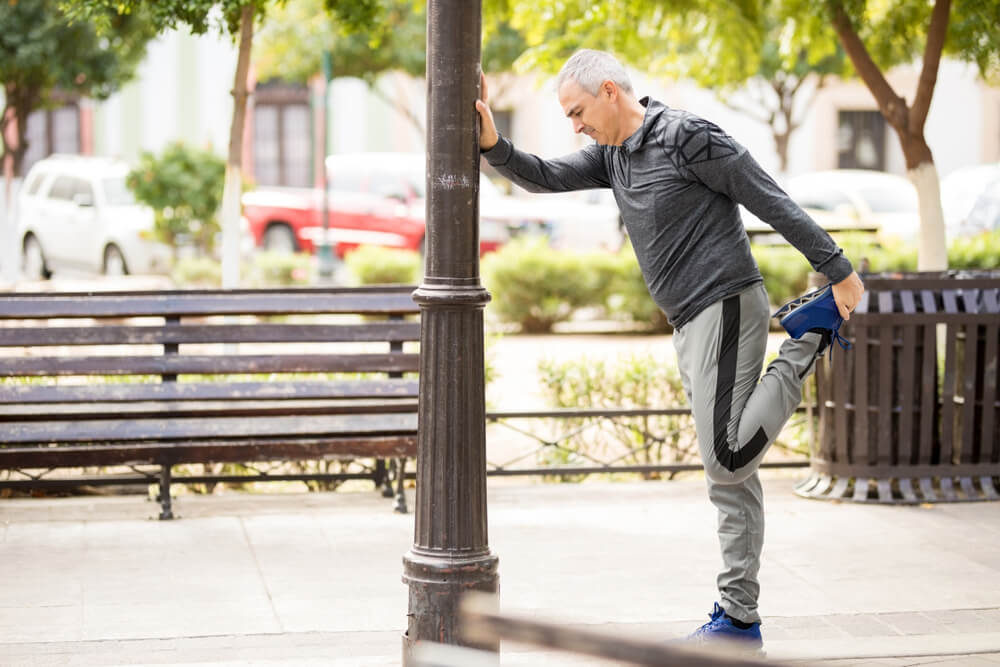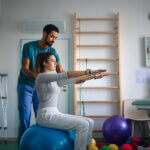Finding effective ways to manage knee arthritis pain is a goal for every person with this condition. However, managing your pain can be much harder if you aren’t stretching the muscles that move and support your knees.
Knee arthritis is one of the most common types of arthritis. It’s estimated that about 10% of men and 13% of women older than age 65 have some level of knee osteoarthritis. Often, the pain of this condition is worse in the morning or after you’ve been sitting for a while. One reason for this is that the muscles around your knees have stiffened up.
Physical therapists can show you how to manage the arthritis pain that this stiffness can cause, and one treatment option that can help with this task is therapeutic exercises. Here are three stretches that you can try that can help manage and even reduce your knee pain:
- Seated hamstring stretch
Purpose: This stretch targets tight hamstring muscles and can help with knee arthritis pain management.
How to perform the seated hamstring stretch:
- Sit on the edge of a stable chair.
- Straighten your arthritic leg out in front of you so that only your heel is touching the floor.
- Keeping your torso as straight as possible, slowly lean forward until you feel a stretch in the back of your thigh.
- Hold this stretch for 20 to 30 seconds.
- Return the upright position and switch legs to stretch your nonarthritic leg.
- Repeatedly stretch the hamstrings of each leg until you’ve done so three times.
- Standing calf stretch
Purpose: Effectively managing knee arthritis pain may also involve stretching the calf muscles, which this exercise can help you accomplish.
How to perform the standing calf stretch:
- Stand about two steps away from a wall.
- Lean forward and place your hands on the wall at about shoulder height.
- Move your nonarthritic leg toward the wall so that your foot is flat on the floor and your knee is slightly bent.
- Stretch the heel of your arthritic leg toward the floor and lean forward until you feel a stretch in your calf.
- Hold this stretch for 15 to 20 seconds.
- Switch legs and stretch the calf of your nonarthritic leg.
- Continue to stretch both legs until you’ve targeted each leg three times.
- Standing quad stretch
Purpose: This stretch can help you manage your knee arthritis pain by reducing tension in your quadriceps muscles.
How to perform the standing quad stretch:
- Place one hand on a wall or stable chair for balance.
- Slowly bend your arthritic knee upward toward your buttocks.
- Grab your ankle with your hand, but do not pull upward your leg.
- Use leg strength to push your ankle up and away from your buttocks.
- Stop when you feel a moderate stretch in the front of your thigh.
- Hold the stretch for 15 to 20 seconds.
- Slowly lower your leg back to the floor.
- Switch legs and repeat the stretch on your nonarthritic leg.
- Repeat the stretch on both legs until you’ve stretched each leg twice.
Peak Performance can help you find effective knee arthritis pain management
Are you looking for help managing or reducing your knee arthritis pain? Our team at Peak Performance Sports & Physical Therapy is keen to help you address your pain. We can do a free screening on your knee to determine how severe your pain is. Then, our physical therapists can create a personalized therapy plan designed to manage and reduce your arthritis pain. You can even meet with us in a virtual therapy session, which allows you to get help with your pain from home.
Contact us today for more information about how we can treat knee arthritis symptoms or to schedule an initial appointment to start addressing your symptoms.







